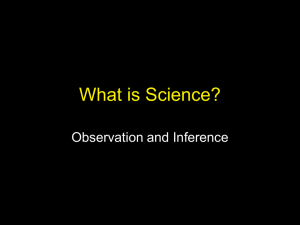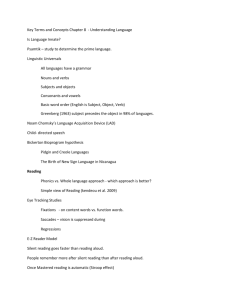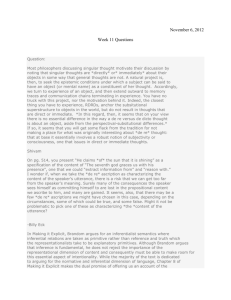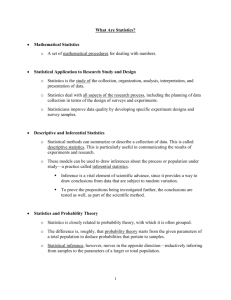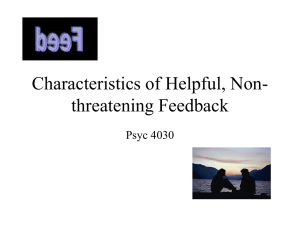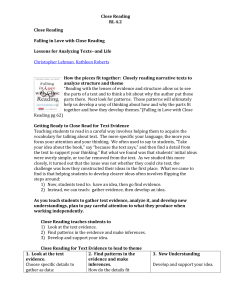- PhilSci
advertisement
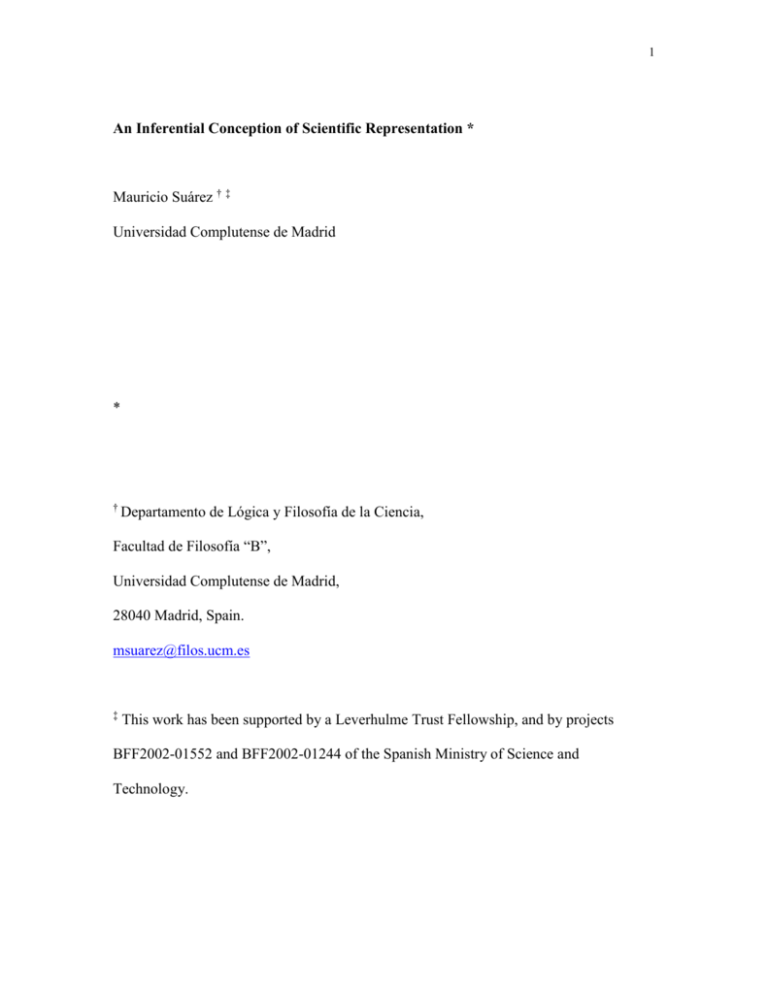
1 An Inferential Conception of Scientific Representation * Mauricio Suárez † ‡ Universidad Complutense de Madrid * † Departamento de Lógica y Filosofía de la Ciencia, Facultad de Filosofía “B”, Universidad Complutense de Madrid, 28040 Madrid, Spain. msuarez@filos.ucm.es ‡ This work has been supported by a Leverhulme Trust Fellowship, and by projects BFF2002-01552 and BFF2002-01244 of the Spanish Ministry of Science and Technology. 2 Abstract This paper defends a deflationary conception of scientific representation. It minimally characterises representation by means of two necessary conditions: its essential intentionality and its capacity to allow surrogate reasoning and inference. The conception is defended by showing that it successfully meets the objections and difficulties that make its competitors, such as isomorphism and similarity, untenable. In addition the inferential conception captures the objectivity of scientific as opposed to ordinary representation, it sheds light on its truth and accuracy, and it explains the source of the analogy between scientific and artistic modes of representation 3 1. Elements of a Theory of Scientific Representation In a representation a source system or object “A” represents a target system or object “B”. Two examples that I will use in this paper are an engineer’s graphical model of a bridge, such as the Forth Rail bridge – an example carefully documented by Michael Baxandall in his (1985); and the quantum state diffusion equation model of a localisation measurement on a quantum particle (see e.g. Percival 1999, 49-51). The aim of a theory of representation is to lay down the general conditions that such disparate models must meet to carry out a representational function: it does not need to go as far as stipulating the conditions for accurate or true representation. In other words, the primary question is not: “how does the graph manage to represent the bridge accurately or truthfully? But rather: “in virtue of what is the graph a representation (however accurate or inaccurate) of the bridge?”. In a companion paper 1 I argue against two substantive conceptions of representation that aim to naturalise the notion of representation by reducing it to the dyadic notions of similarity [sim] and isomorphism [iso]. These conceptions aim to reduce the essentially intentional judgments of representation-users to facts about the source and target objects or systems and their properties. 2 The argument from variety then points to the large diversity and range of representational means in science.3 Some common means of scientific representation 4 include isomorphism, similarity, instantiation, truth, stipulation. Neither is universally employed. Four other arguments show that neither [sim] nor [iso] describe the constituents of representation. The logical argument points out that at least some of the logical properties of representation (non-reflexivity, non-symmetry and non-transitivity) are denied by [sim] and [iso]. The misrepresentation argument shows that [sim] and [iso] can not deal with inaccuracy and/or what I refer to as “mis-targeting” (roughly: the taking of the source to have a target that it doesn’t actually have). The non-necessity and nonsufficiency arguments show that [sim], [iso] are neither necessary nor sufficient for representation. A satisfactory theory of representation must defeat these five arguments; and this minimally requires making explicit what I call the representational force of a source, or its force for short. This is the capacity of a source to lead a competent and informed user to a consideration of the target. Force is a relational and contextual property of the source, fixed and maintained in part by the intended representational uses of the source on the part of agents: No object or system may be said to possess representational force in the absence of any such uses. The contextual character of the ascription of force to sources is made vivid by examples of sources that represent various different targets. A spiral staircase, for example, may be taken to represent the mechanics of a spring, or the structure of DNA: the source’s force varies with intended use. In each case an informed and competent agent will be lead, upon considering the source, towards the correct target; if an agent is simultaneously competent and informed about the use of both 5 representations, or ambivalent, the force of the source will be double or ambiguous respectively. 2. Representation and Surrogate Reasoning: Two Proposals A couple of recent proposals go a considerable way towards meeting these demands. Ibarra and Mormann (2001) reject isomorphism as a basis for scientific representation while suggesting that the notion of homology may provide a more appropriate basis for a sound theory. The use of homology in this context is suggested by Hertz’s discussion of modelling in Prinzipien der Mechanik. A model of a system, according to Hertz, provides us with a representation such that the “intellectually necessary consequences” of the model represent the “naturally necessary consequences” of the system. The advantages of characterising Hertz’s insight in terms of homology as opposed to an isomorphism are several: the target and source need not be the same type of entity, and specifically they need not be structures; and the relation between them need not be structural; hence the dynamical functions that give rise to the “intellectually necessary conditions” of the model need not in any way resemble the dynamical functions that give rise to the “naturally necessary conditions” of the model. Only the end point of these processes stand in a representational relation. RIG Hughes (1997) DDI model (denotation-demonstration-interpretation) develops Nelson Goodman’s (1976) account into a fully fledged theory of scientific 6 representation. Hughes also makes use of Hertz’s insight. According to Hughes, scientific representation may be usefully analysed as a three part notion, which includes the denotation of physical systems and their properties at any one time by means of elements of a model including equations, diagrams, etc; the demonstration of the dynamical consequences of the model; and the interpretation of these consequences back in terms of the physical system and its properties at a later time. Both approaches have several important virtues.4 Unlike [sim] and [iso], they take surrogate reasoning to be the primary function of scientific representation; and they point out the role of representational force. However, instead of taking these two features as the defining features of representation, these proposals seek some deeper constituent relation between the source and the target that will exhibit these features as a by-product. In doing this, they fail to meet all the demands that I have placed on a satisfactory theory of representation. Ibarra and Mormann’s homology fails to meet the logical, misrepresentation and non-sufficiency arguments, since homology obtains whenever an agent’s reasoning about A would enable inferences about B, regardless of whether A’s representational force in fact points to B. Hughes’ DDI model is not a general theory of representation, since denotation, demonstration and interpretation are neither separately necessary nor jointly sufficient conditions on scientific representation. Putting the issue of generality aside, Hughes’ DDI models is closest to the inferential conception that I develop in this paper. The requirement of denotation takes care of force; while the requirement of demonstration distinguishes minimally 7 representation from mere stipulation. There are however two deep and important differences. First, for Hughes representation involves demonstration essentially, and hence requires the actual carrying out of inferences about the target on the part of some agent. In this particular regard the notion of homology seems to have an advantage, and the inferential conception that I will defend does not require the actual carrying out of any of the relevant inferences. Second, Hughes’ (and Goodman’s) denotational criteria would rule out fictional representation, i.e. representations of non-existing entities. Goodman 5 notoriously tried to get around this problem by appealing to the exemplification of conventionally accepted features of fictional entities. For instance, a picture of a unicorn is a “representation” in the sense that the picture exemplifies some features (a horse, and a horn) that are conventionally ascribed to the corresponding fiction. We may then properly speak of the picture of a unicorn as a “unicorn-picture”. Thus what “unicorn-pictures” have in common is not that they denote the same entity or class of entities, but rather that they exemplify the same features. However cunning this solution is, it can not obscure the fact that on any theory of representation as denotation, there is always a sharp difference between a representation of a real object – where the source denotes the target – and a “representation” of a fictional object – which does involve the denotation of what is purportedly represented, and which can only be said to be a “representation” in some derived sense. On the inferential conception to be presented in this paper, on the other hand, there is absolutely no difference in kind between fictional and real-object representation – other than the existence or otherwise of the target. 8 3. An Inferential Conception of Scientific Representation I propose that we adopt from the start a deflationary attitude and strategy towards scientific representation, in analogy to deflationary or minimalist conceptions of truth, or contextualist analyses of knowledge. 6 Adopting a deflationary attitude has two important consequences. First, it entails abandoning the aim of a substantial theory to seek necessary and sufficient conditions on representation. Representation is not the kind of notion that requires a theory to elucidate it: there are no necessary and sufficient conditions for it. We can at best aim to describe its most general features -- finding necessary conditions will certainly be good enough. Second, it entails seeking no deeper features to representation other than its surface features: the representational force of a source is one such irreducible feature; the capacity to allow surrogate reasoning is another. We may express the first feature as follows: Condition 1: A represents B only if the representational force of A points to B. While this condition on its own accommodates some kinds of ordinary representation, such as (on most accounts) the relation of signs to things signified, it can not accommodate scientific representation. For this feature would be satisfied by a mere stipulation of a target for any source. On theories that take representation to be 9 denotation, such as Goodman’s, this is indeed as it should be. I can for instance stipulate that “Samuel” will name my son, thus establishing a representational relation in virtue of a mere act of denotation. But this is not how representation works in science. Scientific representation adds a characteristic form of objectivity to the phenomenological features of ordinary representation. The graph of the Forth Rail Bridge may be taken to represent the City of Edinburgh in a literary or metaphorical sense, as an emblem; but there is no interesting sense in which this representation can be said to be a part of science – not at any rate to the extent that it is a completely conventional sign for it, for in that case it can convey no specific information regarding the city, i.e. no information that any other sign could not equally convey. Similarly the quantum state diffusion equation can be taken to represent someone’s mental or cognitive state in a metaphorical sense. Although these are representations they are not “objective”. I do not mean by this that they are not true nor accurate – most scientific representations are neither. Nor does the argument depend on the targets being non-scientific objects. For neither the graph nor the equation might be taken to represent nuclear fission, for instance, in anything other than a metaphorical sense. By “objective” in this context, I mean informative. More generally the extension of denotational theories of representation to iconic and scientific representation has at least one problematic and counter-intuitive consequence. Suppose that I stipulate that the paper on which I am writing represents the sea, and the two pens that I use to write represent ships on the sea. This act of denotation 10 allows us to correctly draw a few inferences about the ship-on-sea system on the basis of a consideration of the pens-on-paper system, such as for instance that the trajectories of ships may cross and that they may crash. I may have just as well stipulated that the pens will represent the sea and the paper will represent the ships; but this correlation seems counter-intuitive and unnatural. It is certainly less informative, since the relative movements of pens and paper can not allow us, for instance, to infer the possibility that the two ships may crash. The ships-on-sea system is more “objectively” characterised by the first denotational arrangement than by the second. The objectivity of scientific representation is the source of the pervasive metaphor that links it to mirroring.7 For mirroring seems prima facie to characterise it appropriately: the graph “mirrors” the bridge but neither “mirrors” Edinburgh; the equation “mirrors” the motion of a state of a particle and not a mental state; neither of these “mirrors” fission; and the ship-on-the-sea is “mirrored” by the pen-on-the-paper system, rather than the paper-under-the-pen system. Dyadic relations such as correspondence truth, isomorphism or similarity are then brought to the fore as concrete specifications of the mirroring metaphor. Do these relations capture the objectivity of scientific representation? They would, I think, if it was possible to turn them into theories of representation in the first place. But alas it is not possible to do so: None of the proposed specifications of mirroring (truth, similarity, isomorphism) meet the objections raised by the variety, logical, misrepresentation, non-sufficiency and non-necessity arguments. There is a tension between the objectivity of scientific representation, and the phenomenological features of representation in general. 11 The mirroring metaphor is not a particularly helpful one. But if truth, isomorphism and similarity can not be used to capture the objectivity that distinguishes scientific representation, what can? I suggest that we explicitly turn to the second surface feature of scientific representation, i.e. its capacity to allow surrogate reasoning. We may formulate the inferential conception of representation as follows: [inf]: A represents B only if (i) the representational force of A points towards B, and (ii) A allows competent and informed agents to draw specific inferences regarding B. [inf] states two minimal requirements for representation in science. They are stated as requirements on the putative source of a representation, given a putative target. But the reference to the presence of agents and the purposes of inquiry is essential. First, the establishing and maintaining of representational force in (i) requires some agent’s intended uses to be in place; and these will be driven by pragmatic considerations. Second, the type and level of competence and information required in (ii) for an agent to draw inferences regarding B on the basis of reasoning about A is a pragmatic skill that depends on the aim and context of the particular inquiry. [inf] is an abstract description that holds when and only when some concrete representational means apply. It is a scheme that will be filled in differently in each instance of representation. For instance, [inf]’s part (i) leaves open the issue of how many agents are required in a scientific community to fix the representational force of a source, 12 and what the structure of the community and its practices ought to be in order to determine this force. Part (ii) leaves open the issue of what A’s internal structure ought to be like in order to yield correct inferences about B. In particular it does not require that A allow deductive reasoning and inference; any type of reasoning – inductive, analogical, abductive — is in principle allowed, and A may be anything as long as it is the vehicle of the reasoning that leads an agent to draw inferences regarding B. In scientific practice, the requirements expressed in part (i) and part (ii) stand in a dynamical equilibrium. On the one hand the specification of the source and its representational force in part (i) constrains the level of competence and information required of an agent for representation; on the other hand an inquiry into the inferential capacities of A may lead either to shifts in the force of A, or to a reconsideration of what an appropriate source is to represent a given target B. As an example consider the derivation of the quantum state diffusion equation for a measurement process from the stochastic differential equation for the state vector: d = -i/h H dt + j (Lj* Lj - ½ Lj* Lj – ½ Lj* Lj) dt + j (Lj - Lj) dt. This equation represents the evolution of the quantum vector state of a particle subject to a diffusion process. (The first term is just the usual Hamiltonian in the linear Schrödinger equation, the other two terms account for random diffusion and interaction with a larger environment). It is obvious that the mathematical nature of both source and target demand some mathematical competence and a good deal of knowledge of quantum 13 mechanics in order to be able to infer anything at all from this equation! Conversely, a detailed study of the inferential capacities of this equation (Percival 1999, chapters 2-5) suggests that the representational source of a measurement process on a completely open quantum system is given by: d = - ½ Lj2 dt + Lj dt. Having set the intended representational uses for the first equation we are led, by an investigation of the inferences that it licences regarding quantum processes, to accept the force of the second equation points to a measurement on an open system. This search for a dynamical equilibrium between i) and ii) seems to constitute a typical pattern of scientific representational activity. [inf]’s part (ii) has the important function of contributing the objectivity that characterises scientific representation. In contrast to part (i), it in no way depends on an agent’s existence or activity. It requires A to have the internal structure that allows informed agents to correctly draw inferences about B, but it does not require that there be any agents who actually do so.8 And this turns out to be exactly the feature that distinguishes cases of objective scientific representation (however inaccurate) from ordinary representation by arbitrary stipulation. The quantum state diffusion equation has the resources to allow a competent and informed user to draw inferences concerning the state of a quantum particle subject to a localisation procedure. These are not inferences that a competent agent could derive on the basis of any odd equation: they are specific to the chosen source/target pair. On the other hand, the equation does not allow an agent, no matter how competent or informed, to draw any specific inferences (that is, inferences that could not have been derived on the basis of a consideration of any other equation, or 14 any other object for that matter) about someone’s mental or cognitive states, or a process of nuclear fission. Consideration of a graph of the Forth Rail Bridge does not lead an agent to any reliable conclusions regarding the city of Edinburgh (i.e. conclusions that could not have been derived on the basis of a consideration of any other object). 9 4. Arguments in Favour of the Inferential Conception. However minimalist and deflationary, the inferential conception of representation meets all the demands on a satisfactory theory of representation: It avoids the variety, logical, misrepresentation, non-sufficiency and non-necessity arguments. The argument from variety is avoided by construction, since [inf] does not require any specific means of representation, it just requires that there be some means or other. Thus all instances of scientific representation will meet [inf] no matter what specific means (similarity, isomorphism, truth, etc) they employ. [inf] has the logical properties of representation: it is non-reflexive, nonsymmetric and non-transitive. It does not follow from the fact that the representational force of A points to B that it must also point to A itself; nor does it follow that the force of B (if it has any) points to A. The graph’s force points towards the Forth Rail Bridge, not towards the graph itself, and the bridge’s force at best points towards the city, not towards the graph. Transitivity fails too in general since it does not follow from the fact 15 that A’s force points to B, and B’s force points to C, that A’s force also points to C. The graph’s representational force points to the bridge, the bridge is an emblem of the city, but the graph’s force does not henceforth point towards the city. Hence the logical argument is avoided. The misrepresentation argument comes in two forms: inaccuracy and mistargetting. Part (i) of the inferential conception takes care of mistargetting, by explicitly bringing in the notion of force into the definition of representation. Part (ii) of this conception accounts for inaccuracy since it demands that we correctly draw inferences from the source about the target but it does not demand that the conclusions of these inferences be all true, nor that all truths about the target may be inferred. The non-sufficiency argument is doubly taken care of. On the one hand, the inferential conception is deflationary and does not lay down a sufficient condition for representation. In every specific context of inquiry, given a putative target and source, some stronger condition will be met; but which one specifically will vary from case to case. In some cases it will be isomorphism, in other cases it will be similarity, etc. Even once these specifications have been met in any concrete case, the inferential conception will avoid the non-sufficiency argument. This argument turns on the ubiquity of the phenomenon of mistargetting, while [inf]’s part (i) explicitly requires the source’s force to point out the true target of the representation. 16 The inferential conception lays down two necessary conditions on scientific representation. [inf]’s part (i) is necessary for any kind of representation, while part (ii) minimally distinguishes scientific and iconic representation from mere denotation or arbitrary stipulation. The non-necessity argument trades on inaccuracy, but [inf]’s part (ii) only requires strict normative criteria of inference – it does not require the truth or approximate truth of the conclusions derived about the target of the representation. Hence the argument is avoided. 5. The Many Virtues of Inferentialism. I have assumed throughout that it is not required for a satisfactory theory of representation to shed light on representational accuracy, empirical adequacy, or truth. However, the inferential conception has the added virtue to explain these three notions as follows: A representational source licenses inferences regarding its target. The representation is true if it licenses no inferences to false conclusions about the target; it is empirically adequate if it licenses no inferences to false conclusions about the observable or measurable aspects of the target; and it is accurate if it is true and complete, licensing inferences to true conclusions about every aspect of the target. It is important to emphasise that neither “true” nor “accurate” are on this conception of representation equivalent to “mirror”: the source may be non-isomorphic and as dissimilar to the target as it could be, and still licence true conclusions. The QSD equation is not a mirror image of the state’s motion in Hilbert space, but it arguably licenses true conclusions about it. 17 But then neither is artistic representation a case of mirroring. Indeed if the inferential conception is right, scientific representation is in several respects very close to iconic modes of representation, like painting. Representational paintings, such as Velázquez’s portrait of Innocent X permit us to draw inferences regarding those objects that they represent. The Velázquez canvass allows us to infer some personal qualities of the Pope and some of the properties of the Catholic Church as a social institution, as well as the Pope’s physical appearance. But the drawing of these inferences requires a fair amount of knowledge about the social and historical context in which the painting came to be produced. This illustrates an important advantage of [inf] over its competitors, including the DDI model: It is a familiar experience, in the presence of a canvass, to feel that one is not in the epistemic position to be able to draw some of the relevant inferences, yet to be simultaneously aware of the representational character of the canvass. The painting is representational for us too, even if we do not carry out the inferences, since we appreciate that it possesses representational force. In fact a remarkable and important virtue of the inferential conception is its ability to capture the representational / non-representational distinction in art as well as science. Its application to abstract art cuts roughly at the same place as Wollheim’s (1985) “seeing-in” theory. On both accounts much abstract art, including certainly most surrealist and cubist art, turn out to be fully representational. There are similarly fuzzy cases on both accounts, such as Rothko’s paintings, which the artist himself claimed to represent the Holocaust, but whose force is opaque to even the most informed and 18 competent interpreters. Cases of unambiguously non-representational art turn out to be few; Mondriaan’s Diagonal Compositions – which Mondriaan himself explicitly claimed to be “non-objectivist” – may be uniquely exemplary in this regard. 10 One final virtue of the inferential conception is its ability to deal with cases of incompetent use, cognitive dissonance, or imperfect information on the part of the agent. A untrained, incapable or insufficiently informed agent would be unable to correctly apply the QSD equation: we are not thereby inclined to withdraw the claim that the equation actually represents quantum measurements, perhaps even that it represents them accurately. As an illustration of imperfect information consider Einstein’s introduction of the cosmological constant into his GTR field equations, on the assumption of a static universe. The original GTR equations represented all along, of course, even when Einstein was mistakenly led to believe they did not. (There may be yet another turn of the screw to this story, since it is now argued that new evidence suggests that the constant will have to be re-introduced!) 11 Incompetent use, cognitive dissonance or imperfect information may cause agents to incorrectly draw inferences from a source about an intended target, or to draw them about the mistaken target; and perhaps to wrongly decide on the basis of such mistaken inferences that the representation is not accurate, or not a representation at all. The inferential conception explains well how this can happen: the source’s representational force points towards the target; and the source has the resources to allow a competent and informed user to draw inferences regarding the target – it just so happens that these 19 resources are not employed appropriately by the agent. Hence the source appears faulty as a representation, or no representation at all; when as a matter of fact the fault lies entirely with the agent. On the inferential conception, scientific representation, unlike linguistic reference, is not a matter of arbitrary stipulation by an agent, but requires the correct application of functional cognitive powers (valid reasoning) by means that are objectively appropriate to the tasks at hand (i.e. by models that are inferentially suited to their targets). 20 REFERENCES Baxandall, M. (1985), Patterns of Intention: On the Historical Explanation of Pictures. New Haven and London: Yale University Press. Blunt, A. (1969), Picasso’s Guernica. Oxford: Oxford University Press. Earman, J. (2001), “Lambda: The Constant That Would Not Die”, Archive for History of Exact Sciences 55, 189-220. Einstein, A. (1949) in Schlipp, P. (1959), Albert Einstein: Philosopher-Scientist, Harper Torchbooks. Elgin, C. (1997), Between the Absolute and the Arbitrary, Ithaca: Cornell University Press. Field, H. (1972), “The Deflationary Conception of Truth”, in Fact, Science and Morality, G. MacDonald and C. Wright (eds.). Oxford: Blackwell. Gamow, G. (1970), My World Line. New York: Viking Press. Giere, R. (forthcoming), “How Models are Used to Represent Reality”, this volume. Goodman, N. (1976), Languages of Art. Indianapolis: Hackett. Horwich, P. (1990), Truth. Oxford: Blackwell. Hughes, RIG. (1997), “Models and Representation”, Philosophy of Science, 64, S325S336. Ibarra, A., and T. Mormann (2001), “Una teoría combinatoria de las teorías científicas”, Crítica, vol. XXXII, no. 95. Percival, I. (1999), Quantum State Diffusion. Cambridge : Cambridge University Press. 21 Rorty, R. (1980), Philosophy and the Mirror of Nature. Princeton: Princeton University Press. Suárez, M. (1999), “Theories, models and representations”, in Model-Based Reasoning in Scientific Discovery, ed. L. Magnani et al. (eds.), 75-83. New York: Kluwer Academic Press. Suárez, M. (forthcoming), “How not to naturalise scientific representation”, submitted to International Studies in the Philosophy of Science. Van Fraassen, B. (1994), “Interpretation of science: Science as interpretation”, in J. Higevoord (ed.), Physics and Our View of the World. Cambridge: Cambridge University Press. Van Fraassen, B. (2000), “The theory of tragedy and of science: does nature have narrative structure?”, in Sfendoni-Mendou (ed.), Aristotle and Contemporary Science, vol. 1. New York: Peter Lang. Williams, M. (1996), Unnatural Doubts. New Jersey: Princeton University Press. Wollheim, R. (1987), Painting as an Art. London: Thames and Hudson. 22 FOOTNOTES 1 “How not to Naturalise Scientific Representation”, submitted to International Studies in the Philosophy of Science. 2 Bas Van Fraassen and Ronald Giere are sometimes misunderstood to be defenders of [iso] and [sim] respectively. Yet Van Fraassen has explicitly defended an intentional conception of representation (Van Fraassen 1994 and 2000). And Giere, in his contribution to this symposium (Giere, forthcoming) is explicit that representation is a four-place relation, and thus not reducible to (dyadic) similarity. 3 The means of A’s representation of B is the relation that holds between A and B that is employed by an agent who draws inferences regarding B on the basis of reasoning about A. The constituents of the representation is the relation (if any) between A and B that is necessary and sufficient for A to represent B. 4 In some ways the inferential conception that I defend in this paper is an extension of these approaches – I am grateful to Andoni Ibarra and RIG Hughes for sending me their work. 5 (Goodman 1976, 21ff). See also (Elgin 1997, chapters 8, 9). 23 6 A minimalist conception of truth is defended, among others, by (Horwich 1990); (Williams 1996) defends a similar minimalism with regards to knowledge. What both approaches have in common is the rejection of the need, or appropriateness, for any substantive theory of these concepts. 7 A metaphor at the heart of Rorty’s (1979) wholesale attack on representation. 8 Note that “correctly drawing inferences” is not equivalent to “drawing inferences to true conclusions”. A photograph showing me enthusiastically waving the Union Jack in a crowd at the Queen’s parade may lead an informed and competent inquirer to infer the false conclusion that I am British. The normative standards of correctness required by [inf] are inferential merely, and do not depend on the truth or otherwise of premises or conclusions. 9 Emblems, like ordinary names, are often more than mere arbitrary stipulations. The history of an emblem, the choice of a name, often reveals meaningful information about the object or person denoted. This means that in practice emblems, and names, are not mere denoting signs, but also play a connotative function, and can too exhibit the objectivity of scientific representations. 10 Rothko’s paintings, like Picasso’s Guernica, raise the interesting issue of whether the objective representational force of a painting is always transparent to the artist, and if so whether it necessarily dovetails with the artist’s own conscious intended interpretation. I 24 agree with (Baxandall 1985) that it makes methodological sense to presume that the answer is positive in general, but I also agree with (Blunt 1969) that there are cases where this need not be so. 11 Gamow recounts that Einstein came to regard the introduction of the cosmological constant as his “biggest blunder”. (Gamow 1970, 44). (Earman 2001) provides a good historical overview.

